When we traveled to Antarctica in 2008, our guide had waxed eloquent about how much he hoped someday to visit Tristan da Cunha, the most remote human habitation on the planet. We had never heard of it, but Jim never forgot his comments. A year or so later Elderhostel advertised a cruise across the South Atlantic that included a stop at Tristan. Jim was sold. Mary Ellena was captivated by the chance to revisit Tierra del Fuego and the Falklands. So we signed up. It was the trip of a lifetime in more ways than one!
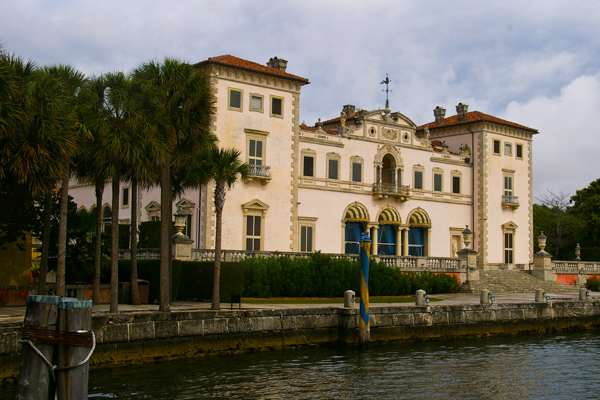 Not wanting to risk missing our plane to Buenos Aires, we went down
to Miami a day ahead and spent the time at
Vizcaya - a marvelous house
museum of the early 20th century.
Not wanting to risk missing our plane to Buenos Aires, we went down
to Miami a day ahead and spent the time at
Vizcaya - a marvelous house
museum of the early 20th century.That evening we met most of our group at the airport for the flight to Argentina.
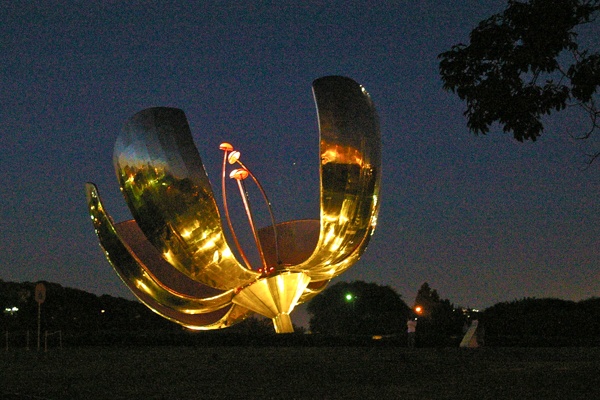 When in Buenos Aires in 2008 we had been charmed by the huge sculpture
of a flower called "Floralis
Generica." Since it was within walking distance of our hotel,
we wandered down to see it lighted at night.
When in Buenos Aires in 2008 we had been charmed by the huge sculpture
of a flower called "Floralis
Generica." Since it was within walking distance of our hotel,
we wandered down to see it lighted at night.Lovely! The mechanism that used to close the petals at night is no longer working, but it is still beautiful.
Many locals strolled by and there were others across the boulevard playing soccer. Down the street young people were gathered outside the art museum.
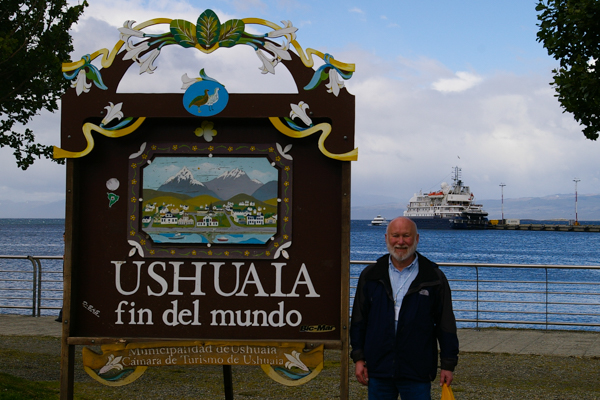 After a night in Buenos Aires we flew to Ushuaia to meet the
Corinthian II, which can be seen behind Jim.
After a night in Buenos Aires we flew to Ushuaia to meet the
Corinthian II, which can be seen behind Jim.It was the only ship in the harbor this late in the austral summer. All the rest had already left. We were about to leave on the "repositioning cruise" that would take the ship across the Atlantic for its summer season in the Mediterranean.
When we visited Ushuaia in December, 2008, the pier was crowded with passenger and cargo ships.
.jpg) At
West Point Island we visited the same rookery we saw in 2008. Before,
in December, there were many
Rockhopper
penguins brooding their eggs or their little ones. Now, in February,
most of the Rockhoppers were gone and the
black-browed albatross were tending their chicks.
At
West Point Island we visited the same rookery we saw in 2008. Before,
in December, there were many
Rockhopper
penguins brooding their eggs or their little ones. Now, in February,
most of the Rockhoppers were gone and the
black-browed albatross were tending their chicks.This not-so-little one is begging its parent to regurgitate dinner. Yum!
At this point the albatross chicks were starting to grow into their adult feathers.
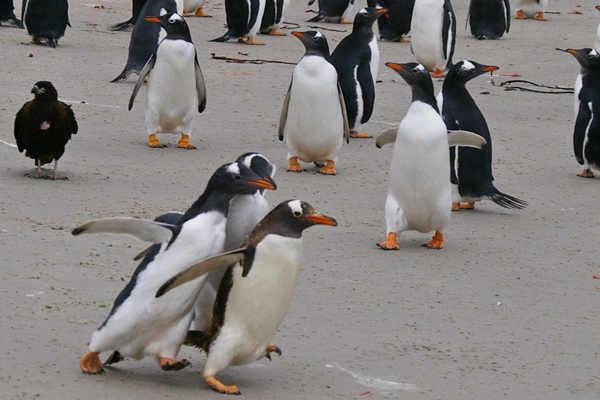 We next visited
Saunders
Island where there were groups of
gentoo,
king and rockhopper
penguins as well as other birds.
We next visited
Saunders
Island where there were groups of
gentoo,
king and rockhopper
penguins as well as other birds.Gentoos, which raise two chicks each breeding season, were the most numerous. This poor parent, who is being pursued by hungry brats, may be wishing he (or she) never heard of babies.
The adult bird is beginning the moult and can't even fish for itself let alone two demanding youngsters. They, on the other hand, are fully fledged and could find their own dinners.
.jpg) Our next stop in the Falklands was Stanley, the capital.
Our next stop in the Falklands was Stanley, the capital.Christ Church Cathedral in Port Stanley is the southernmost Anglican cathedral.
The whalebone arch comemmorates the commercial whaling activities administered from here in the first half of the 20th century.
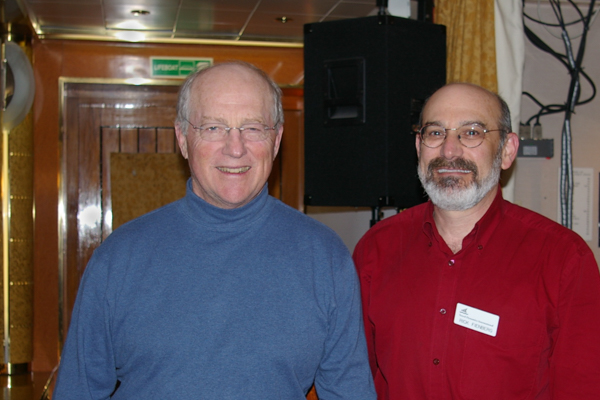 We were three days at sea between the Falklands and South Georgia, but
we were by no means bored.
We were three days at sea between the Falklands and South Georgia, but
we were by no means bored.The "Southern Skies" portion of the theme was provided by former astronaut Rick Hauck (L) and Rick Fienberg, editor emeritus of Sky and Telescope magazine.
They gave us entertaining and thoughtful lectures about space exploration and cosmology. Unfortunately we only had one night that was suitable for star-gazing.
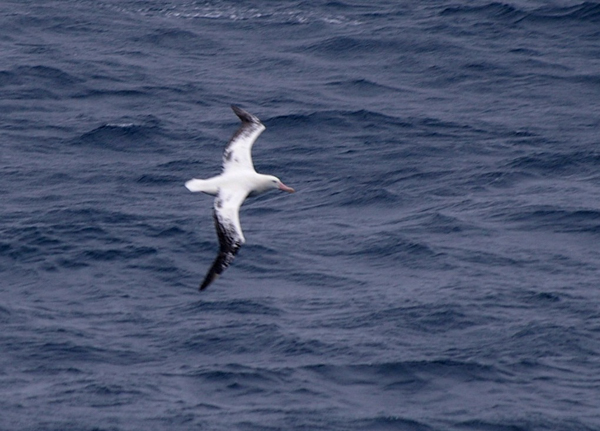 While at sea, in addition to lectures, films and the excellent food &
drink, we also enjoyed watching the sea birds and a few sea mammals.
While at sea, in addition to lectures, films and the excellent food &
drink, we also enjoyed watching the sea birds and a few sea mammals.The Wandering Albatross is the largest flying bird with a wingspan of up to 12 feet. (Scale is hard to judge at sea.) These beautiful birds are threatened by long line fishing.
We saw several albatross species on our travels.
.jpg) The last day out we passed close to
Shag
Rocks, which are rocky prominences rising from the depths of the
South Atlantic.
The last day out we passed close to
Shag
Rocks, which are rocky prominences rising from the depths of the
South Atlantic.These six small islands, inhabited only by sea birds, are located on the South Georgia ridge south of the Antarctic Convergence and 150 miles west of the main island.
This picture shows why we didn't have great star-gazing conditions.
The still picture is deceiving - the ship was tossing here!
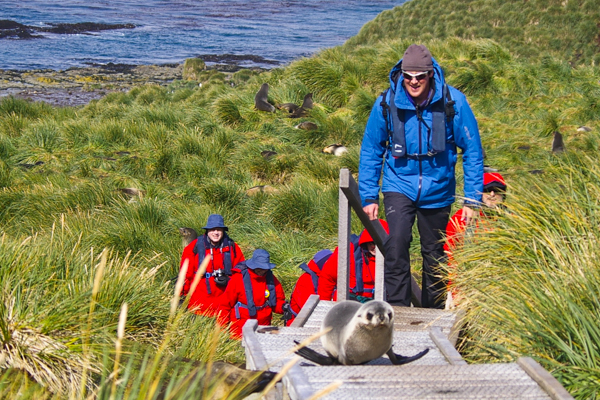 Our first planned stop in
South Georgia
was unsafe for landing due to high winds, but we had a successful visit
to Prion Island in the Bay of Isles.
Our first planned stop in
South Georgia
was unsafe for landing due to high winds, but we had a successful visit
to Prion Island in the Bay of Isles.The boardwalk had been built to protect the environment, but we weren't the only ones that found it a useful thoroughfare. Many Southern Fur Seals make their homes here.
We also saw nesting Wandering Albatrosses and the rare South Georgia Pipit.
Ken Wright (in blue) was one of the expedition staff. He is a naturalist from Lillooet, Canada.
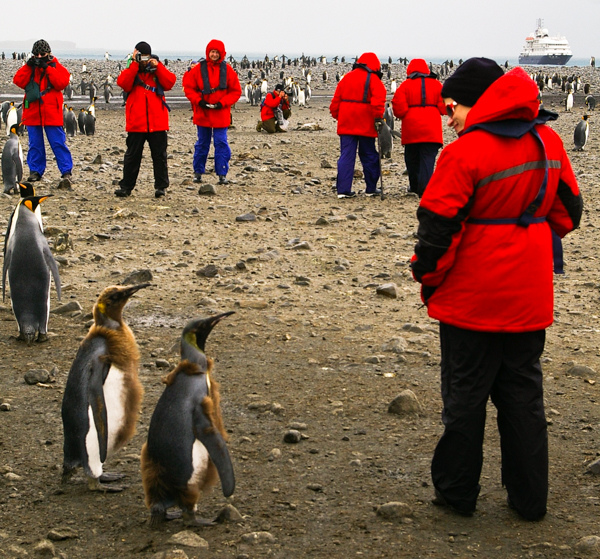
This is one of the few flat areas on South Georgia and was briefly considered for an airstrip immediately after the Falklands War. Thankfully that idea died.
These friendly young penguins are shedding the brown fuzz that gives them the nickname "Oakum boys." They are hoping that Susan Fienberg will feed them.
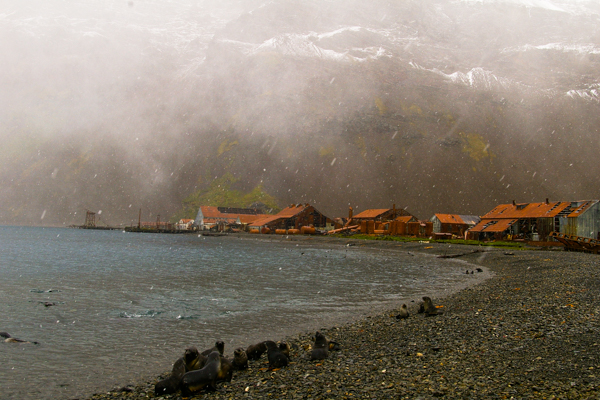 After our first day's explorations, the ship spent the night in Fortuna
Bay. The next morning a small group of intrepid hikers took a Zodiac
ashore and retraced part of
Sir Ernest
Shackleton's epic journey over the mountains of South Georgia. They
were led by Trevor Potts of
our expedition staff. Trevor had recreated Shackleton's entire journey
from Elephant Island to South Georgia in a replica of the James Caird.
After our first day's explorations, the ship spent the night in Fortuna
Bay. The next morning a small group of intrepid hikers took a Zodiac
ashore and retraced part of
Sir Ernest
Shackleton's epic journey over the mountains of South Georgia. They
were led by Trevor Potts of
our expedition staff. Trevor had recreated Shackleton's entire journey
from Elephant Island to South Georgia in a replica of the James Caird.The rest of us were content to munch on breakfast while the ship took us to Stromness where we picked up the hikers.
In addition to seals and penguins we also saw reindeer at this site.
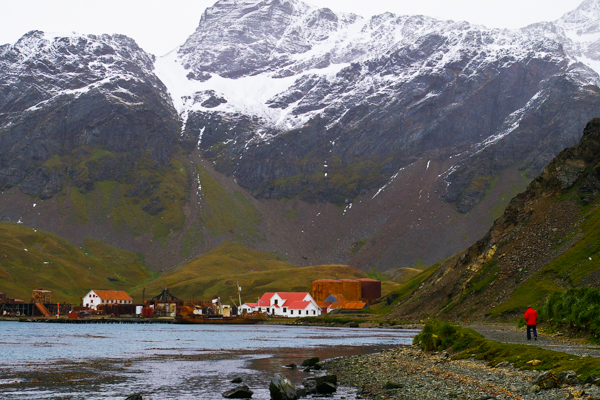 Our next stop was
King Edward Point. Shortly after our arrival most of the travellers
accompanied Trevor and the rest of the expedition staff on Zodiacs to
offer the traditional toast at Sir Shackleton's grave.
Our next stop was
King Edward Point. Shortly after our arrival most of the travellers
accompanied Trevor and the rest of the expedition staff on Zodiacs to
offer the traditional toast at Sir Shackleton's grave.Everyone then explored the old whaling station, which is now a museum. The large white building is the interpretive center (and gift shop), but the museum comprises all the remaining buildings and machinery. The local post office was also a popular destination.
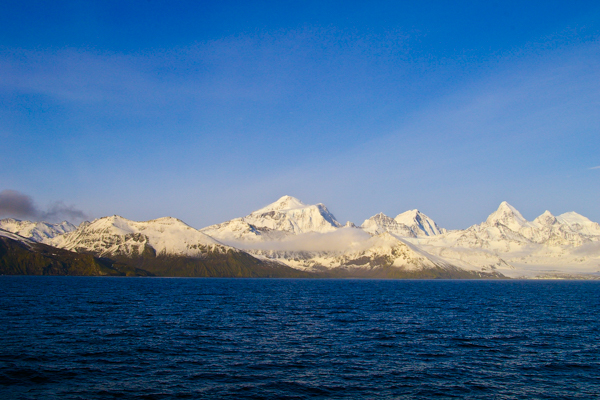 Early the next morning we left King Edward Point. The weather was glorious,
for a change, and I took a picture before going to breakfast. Good thing.
By the end of breakfast, it had clouded over again.
Early the next morning we left King Edward Point. The weather was glorious,
for a change, and I took a picture before going to breakfast. Good thing.
By the end of breakfast, it had clouded over again.South Georgia was the high point of our trip. I wish we had seen more of it in the sun.
.jpg) The King penguin colony here is estimated to be home to 250,000 birds.
The sight is breathtaking. As is the racket. The birds recognize each
other by their voices, so there is a constant clamor as homing birds
return to locate their families.
The King penguin colony here is estimated to be home to 250,000 birds.
The sight is breathtaking. As is the racket. The birds recognize each
other by their voices, so there is a constant clamor as homing birds
return to locate their families.Kings are unique in that their 18-month life-cycle means that a colony will have birds in all stages of mating, brooding eggs and feeding young chicks at the same time.
.jpg) We bid farewell to South Georgia with a cruise down Drygalski Fjord
at the eastern-most tip of the island.
We bid farewell to South Georgia with a cruise down Drygalski Fjord
at the eastern-most tip of the island.The rocks here are the oldest on South Georgia and date back to the massive Gondwana continent.
Numerous glaciers come down to the water and split off the ice that we cruised through almost to the end of the fjord.
Now we set our course for Tristan da Cunha.
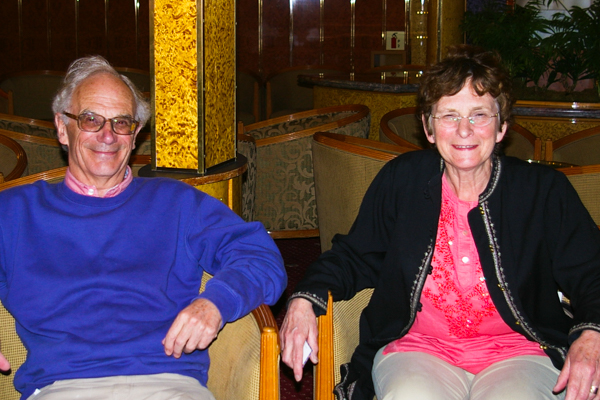 In addition to the "Skies" portion of the program, we were
privileged to have
Piers Brendon and his wife Vyvyen as lecturers on the history of
the far-flung British Empire.
In addition to the "Skies" portion of the program, we were
privileged to have
Piers Brendon and his wife Vyvyen as lecturers on the history of
the far-flung British Empire.The Falklands/South Georgia and South Africa have played pivotal roles in empire and our current destination, Tristan da Cunha is also a British outpost.
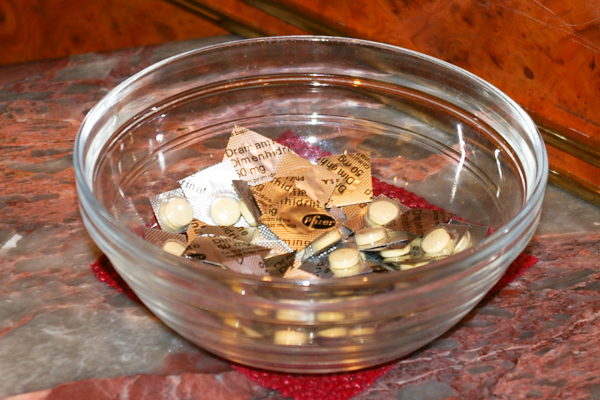 We were not blessed with smooth sailing. It wasn't a surprise because
the South Atlantic is notorious for its unsettled conditions. We were
amused, however, that instead of the typical bowl of mints at the reception
desk, the crew had set out this handy supply of Dramamine.
We were not blessed with smooth sailing. It wasn't a surprise because
the South Atlantic is notorious for its unsettled conditions. We were
amused, however, that instead of the typical bowl of mints at the reception
desk, the crew had set out this handy supply of Dramamine.Personally, as a confirmed land-lubber, I found the Scopolamine patch worked well.
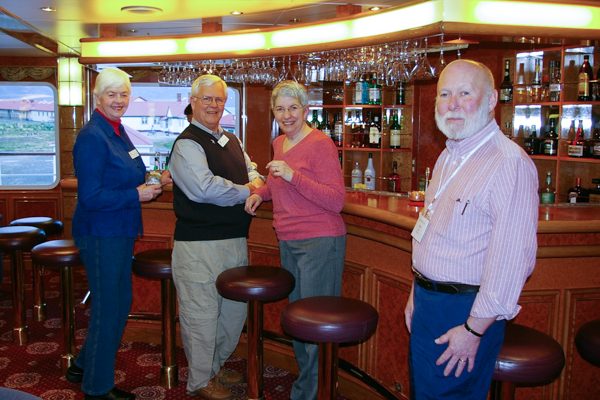 Although this picture is taken at dock in King Edward Point, a feature
of each afternoon at sea was happy hour.
Although this picture is taken at dock in King Edward Point, a feature
of each afternoon at sea was happy hour.The passengers would gather for a favorite libation and the constant supply of finger food.
Pictured are Mair and Hugh Lewis, Merle Wexler and Jim.
There was also an extensive library on board, a jigsaw puzzle, satellite internet service and other games to amuse us.
Ten times around the promenade deck was a mile and many passengers put in their daily laps - even with the wind and spray from the waves.
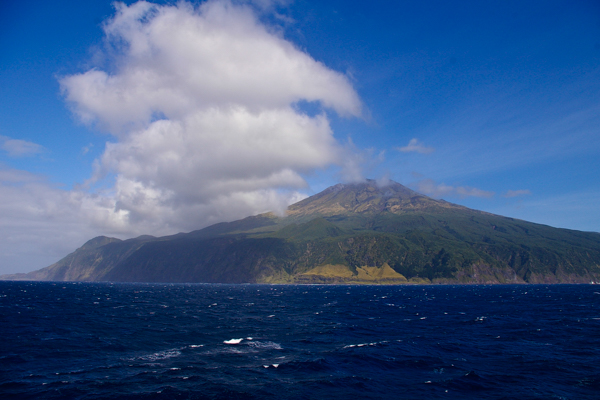 After four days at sea we arrived at Tristan. The island is a volcano
in the middle of the South Atlantic.
After four days at sea we arrived at Tristan. The island is a volcano
in the middle of the South Atlantic.It is part of an archipelago of four major islands: Tristan, Nightingale, Inaccessible and Gough, all of which were formed as the African plate moved over a "hot spot" beneath the ocean floor.
Tristan is the newest of the islands by a large margin - an estimated 200,000 years old.
It was too rough to land, so we cruised to Nightingale.
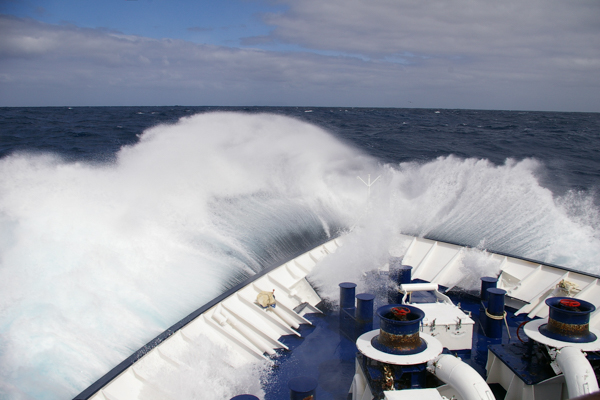 It didn't look too rough in the above picture, but this gives a better
image.
It didn't look too rough in the above picture, but this gives a better
image.I'm standing on deck 4 overlooking deck 3. This was not the largest splash I saw before finally going inside to dry off.
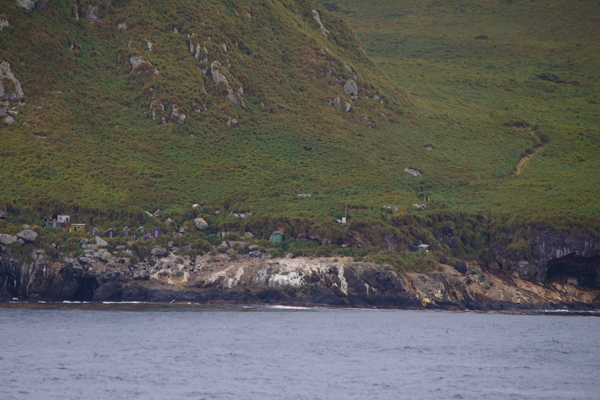 Nightingale is the breeding grounds of numerous birds including the
Northern Rockhopper penguin. Take my word for it, they are in this
picture along the top of the guano-stained rock.
Nightingale is the breeding grounds of numerous birds including the
Northern Rockhopper penguin. Take my word for it, they are in this
picture along the top of the guano-stained rock.Unfortunately the weather still prohibited a landing here.
The buildings are cabins where Tristan islanders may stay when they visit here to "get away from it all."
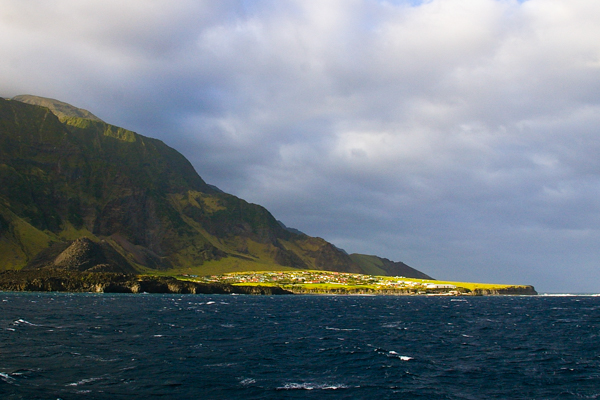 The only town on Tristan was named after the Duke of Edinburgh, who
visited many years ago.
The only town on Tristan was named after the Duke of Edinburgh, who
visited many years ago.At the left of the picture low on the mountain slope may be seen the cinder cone from the 1961 eruption that forced the evacuation of the islanders to England. After the eruption died down, they returned. The current population is around 270.
Edinburgh has all the modern conveniences except credit cards.

On the morning of our 2nd day we did get to shore.
The paper is the local Lexington News-Gazette. Every year they ask travelers to take a copy on vacation and submit pictures. Yes, this one got published and we had our 15 minutes of fame.
The captain of our ship had been to the island five times before and this was the first time he actually got onshore. We were very lucky!
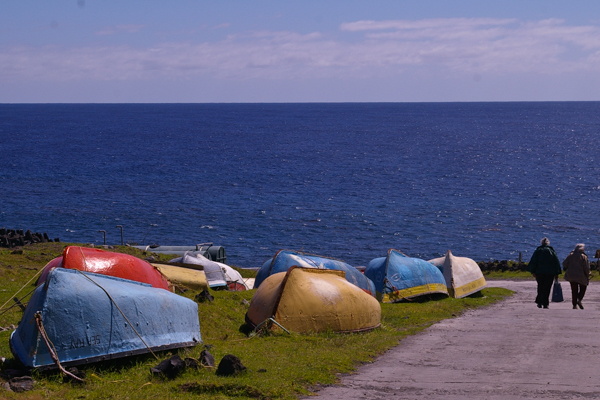 Tristan's economy is based on fishing. The largest cash "crop"
is rock lobster. As a result boats are much in evidence.
Tristan's economy is based on fishing. The largest cash "crop"
is rock lobster. As a result boats are much in evidence.These are spares that have been secured against the strong winds that are so common here.
In the old days these boats would have been made of sealed and painted canvas. Nowadays they are made of fiberglass.
Several Tristaners traveled with us to Cape Town as did one Cape Town resident who had been vacationing on the island.
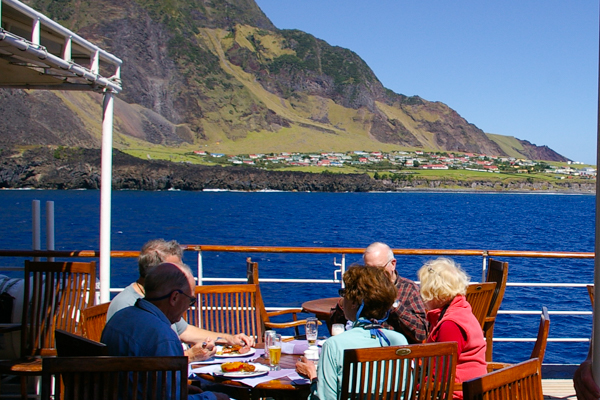 As we left Tristan we enjoyed one of the few days of calm seas. The
ship's staff set up a grill on deck and barbecued fresh-caught fish
and the local rock lobsters.
As we left Tristan we enjoyed one of the few days of calm seas. The
ship's staff set up a grill on deck and barbecued fresh-caught fish
and the local rock lobsters.
It would have been lovely to be able to eat outside more often, but the weather did not permit it more than about three days.
Our final destination is Cape Town - four days cruise away.
 While at sea we returned to our routine of lectures, video presentations,
reading and conversation.
While at sea we returned to our routine of lectures, video presentations,
reading and conversation.John Frick, the expedition leader, even gave several readings - including The Rime of the Ancient Mariner with its warning against harming albatrosses.
Some of us were looking forward to getting home. Others wished the cruise would never end.
.jpg) Finally we were back in sight of land. The city of Cape Town sprawls
along the seacoast and wraps around Table Mountain.
Finally we were back in sight of land. The city of Cape Town sprawls
along the seacoast and wraps around Table Mountain.We were to spend two days touring this area before catching our plane for the long ride back to the US.
It was a blessing to be in a harbor after one of our roughest cruising days and nights.
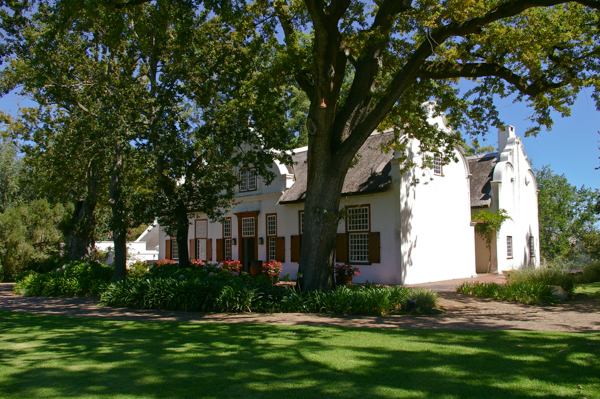 Our first day was spent driving to the South African wine country. The
landscape is quite beautiful and the wines ain't bad either.
Our first day was spent driving to the South African wine country. The
landscape is quite beautiful and the wines ain't bad either.This "Cape Dutch" home at the Blaauwklippen winery was built in the late 17th century.
We also visited the town of Stellenbosch.
.jpg) No reading of history quite prepared me for the actual squalor of the
South African "townships."
During the days of
apartheid black Africans had been forced to live in these worse-than-slums
and many still do.
No reading of history quite prepared me for the actual squalor of the
South African "townships."
During the days of
apartheid black Africans had been forced to live in these worse-than-slums
and many still do.The government is struggling to provide decent housing for these residents, but the process is taking a long time because of a legacy of distrust and abuse.
.jpg) There was much beautiful scenery around the
Cape
of Good Hope - but this
cape baboon family was unique.
There was much beautiful scenery around the
Cape
of Good Hope - but this
cape baboon family was unique.In spite of what you may have learned in school, the Cape of Good Hope is NOT the southernmost point of Africa. That honor belongs to Cape Agulhas, which we did not visit.
.jpg) There is a colony of
African penguins that has taken up residence on an urban beach on
the Cape peninsula.
There is a colony of
African penguins that has taken up residence on an urban beach on
the Cape peninsula.
Their "song" sounds exactly like a donkey's bray and they were once called "Jackass penguins" before they received a more polite designation.
They are similar to the Magellanic penguins that we saw in the Falklands.
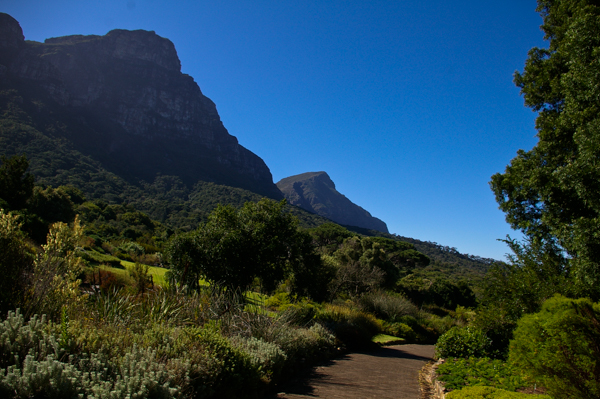 This garden on the back side of Table Mountain was stunningly beautiful.
This garden on the back side of Table Mountain was stunningly beautiful.There were many lovely vistas and the individual plants were beautiful as well. There were numerous habitats and a vast variety.
I could have spent many more hours here.
But we had a plane to catch.
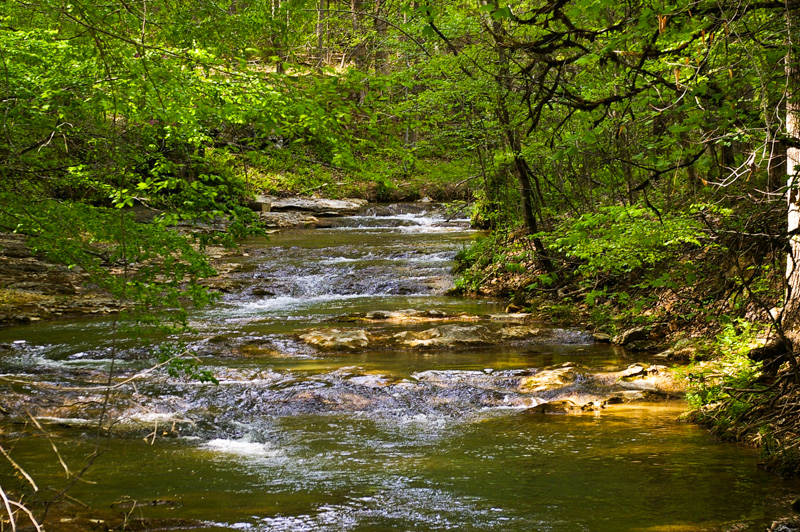
I may travel the world over, but I don't think there is anyplace prettier than Rockbridge County, Virginia. Especially in the spring.
This is Poague Run at Windward Farm, where I once boarded my horses.